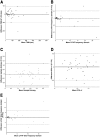Feasibility, Reliability and Predictive Value Of In-Ambulance Heart Rate Variability Registration
- PMID: 27144492
- PMCID: PMC4856404
- DOI: 10.1371/journal.pone.0154834
Feasibility, Reliability and Predictive Value Of In-Ambulance Heart Rate Variability Registration
Abstract
Background: Heart rate variability (HRV) is a parameter of autonomic nervous system function. A decrease of HRV has been associated with disease severity, risk of complications and prognosis in several conditions.
Objective: We aim to investigate the feasibility and the reliability of in-ambulance HRV registration during emergency interventions, and to evaluate the association between prehospital HRV parameters, patient characteristics, vital parameters and short-term outcome.
Methods: We conducted a prospective study using a non-invasive 2-lead ECG registration device in 55 patients transported by the paramedic intervention team of the Universitair Ziekenhuis Brussel. HRV assessment included time domain parameters, frequency domain parameters, nonlinear analysis, and time-frequency analysis. The correlation between HRV parameters and patient and outcome characteristics was analyzed and compared to controls.
Results: Artifact and ectopic detection rates were higher in patients during ambulance transportation compared to controls in resting conditions, yet technical reasons precluding in-ambulance HRV analysis occurred in only 9.6% of cases. HRV acquisition was possible without safety issues or interference with routine emergency care. Reliability of the results was considered sufficient for Sample entropy (SampEn), good for the ratio of low frequency and high frequency components (LF/HF ratio) in the frequency and the time frequency domain, and excellent for the triangular interpolation of the NN interval histogram (TINN), and for the short-term scaling exponent of the detrended fluctuation analysis (DFA α1). HRV indices were significantly reduced inpatients with unfavorable outcome compared to patients with favorable outcome and controls. Multivariate analysis identified lower DFA α1 as an independent predictor of unfavorable outcome (OR, 0.155; 95% CI 0.024-0.966; p = 0.049).
Conclusion: In-ambulance HRV registration is technically and operationally feasible and produces reliable results for parameters in the time, frequency, nonlinear and time frequency domain. Especially non-linear HRV analysis during emergency ambulance transportation may be a promising approach to predict patient outcome.
Conflict of interest statement
Figures


Similar articles
-
Normal ranges and reproducibility of statistical, geometric, frequency domain, and non-linear measures of 24-hour heart rate variability.Horm Metab Res. 1999 Dec;31(12):672-9. doi: 10.1055/s-2007-978819. Horm Metab Res. 1999. PMID: 10668921
-
Predicting survival in heart failure case and control subjects by use of fully automated methods for deriving nonlinear and conventional indices of heart rate dynamics.Circulation. 1997 Aug 5;96(3):842-8. doi: 10.1161/01.cir.96.3.842. Circulation. 1997. PMID: 9264491
-
[Relationships among frequency domain and non-linear parameters from heart rate variability].Rinsho Byori. 2011 Aug;59(8):770-3. Rinsho Byori. 2011. PMID: 21942087 Japanese.
-
Correlation properties of heart rate variability during endurance exercise: A systematic review.Ann Noninvasive Electrocardiol. 2020 Jan;25(1):e12697. doi: 10.1111/anec.12697. Epub 2019 Sep 9. Ann Noninvasive Electrocardiol. 2020. PMID: 31498541 Free PMC article.
-
Chronomics for chronoastrobiology with immediate spin-offs for life quality and longevity.Biomed Pharmacother. 2003 Oct;57 Suppl 1:1s-18s. doi: 10.1016/j.biopha.2003.08.018. Biomed Pharmacother. 2003. PMID: 14572671 Review.
Cited by
-
Physiological Variability during Prehospital Stroke Care: Which Monitoring and Interventions Are Used?Healthcare (Basel). 2024 Apr 15;12(8):835. doi: 10.3390/healthcare12080835. Healthcare (Basel). 2024. PMID: 38667597 Free PMC article. Review.
-
Fingolimod initiation in multiple sclerosis patients is associated with potential beneficial cardiovascular autonomic effects.Ther Adv Neurol Disord. 2017 Apr;10(4):191-209. doi: 10.1177/1756285616682936. Epub 2017 Jan 6. Ther Adv Neurol Disord. 2017. PMID: 28507603 Free PMC article.
-
Relation between Heart Rate Variability and Disease Course in Multiple Sclerosis.J Clin Med. 2019 Dec 18;9(1):3. doi: 10.3390/jcm9010003. J Clin Med. 2019. PMID: 31861312 Free PMC article.
-
Regulating autonomic nervous system homeostasis improves pulmonary function in rabbits with acute lung injury.BMC Pulm Med. 2017 Jul 3;17(1):98. doi: 10.1186/s12890-017-0436-0. BMC Pulm Med. 2017. PMID: 28673269 Free PMC article.
-
Development of a heart rate variability and complexity model in predicting the need for life-saving interventions amongst trauma patients.Burns Trauma. 2019 Apr 18;7:12. doi: 10.1186/s41038-019-0147-2. eCollection 2019. Burns Trauma. 2019. PMID: 31019983 Free PMC article.
References
-
- Su IC, Li CH, Wang KC, Lai DM, Huang SJ, Shieh JS, et al. Prediction of early secondary complications in patients with spontaneous subarachnoid hemorrhage based on accelerated sympathovagal ratios. Acta neurochirurgica. 2009;151(12):1631–7. Epub 2009/10/07. 10.1007/s00701-009-0517-9 . - DOI - PubMed
MeSH terms
LinkOut - more resources
Full Text Sources
Other Literature Sources
Research Materials
Miscellaneous

